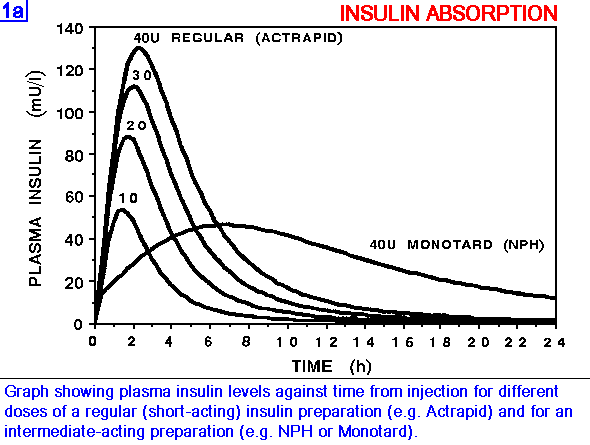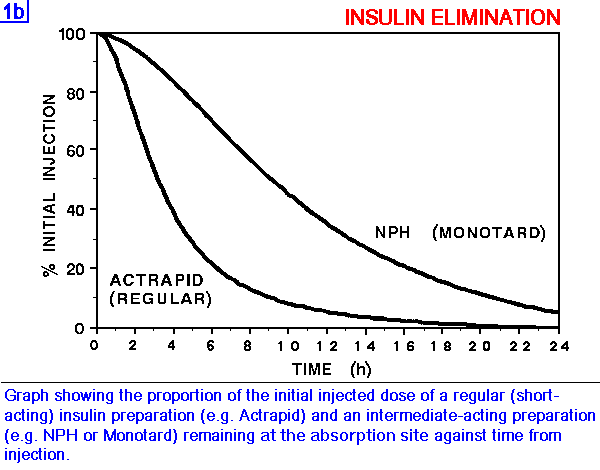A form of diabetes in which the body is either underproducing insulin, or underproducting insulin receptors, and is therefore unable to break down glucose in the blood.
Background
Diabetes is a disease in which the body has too much glucose, a simple sugar, in the blood. The normal person has 80-90 mg glucose/dl of blood, which increases to 120-140 mg/dl after a meal, whereas the diabetic has glucose levels which can reach as high as 1200 mg/dl in extreme cases. The key element in glucose regulation is insulin, a hormone that is normally naturally produced by the pancreas. Beta-cells in the pancreas make insulin, then insulin helps the cells to take in the necessary glucose. In diabetics, either insulin is not produced, or insulin receptors are reduced. Diabetes is largely hereditary, some people have beta cells which are naturally susceptible to destruction by viruses or have immune systems which have developed antibodies against the beta cells. Obesity can cause diabetes by reducing the number of insulin receptors in the body decreasing the effectiveness of insulin.
When there is too much glucose in the blood, the cells of the body are not getting enough energy. Although symptoms vary depending on the type of diabetes and the patient, short-run symptoms include fatigue, extreme hunger and thirst, weight loss, headaches and loss of glucose in the urine. In extreme cases, high glucose levels can cause comas. In the long-run excess glucose in the blood can cause damage to the eyes, kidneys, nerves, and heart.
There are three main types of diabetes, type I, type II, and gestational diabetes:
Type I Diabetes
-Type I diabetes (also called juvenille onset diabetes) results from a body not producing insulin due to some sort of damage to the pancreas. This damage can be an autoimmune response against insulin, susceptiblity of the beta cells to viral attack, or a tendency towards beta-cell degradation. Symptoms include weight loss, intense hunger and thirst, sugar in the urine, fatigue, and even coma.
Type II Diabetes
- Type II diabetes, the most common form, can result either from the body underproducing insulin, or from insulin receptor reduction. Symptoms include headache, blurred vision, and intense thirst and hunger.
Gestational Diabetes
Gestational Diabetes is a temporary condition which affects women later in their pregnancy. The mother develops an insulin resistance during pregnancy, and consequently experiences high blood sugar levels. This condition can impact the baby if untreated, causing high glucose and insulin levels and increasing chances of childhood obesity.
Treatment
There are several treatment options in diabetes, and usually a combination of methods are used. The main methods include insulin injections, diabetes pills, regulation of diet, and excercise. (note: in this case study the factors you can control are diet and insulin injections)
Insulin Injections
-Insulin injections work by placing insulin into the blood to break down glucose. In this case study, there are two types of insulins, short-acting (Actrapid-like) insulin preparations, and intermediate-acting (NPH-like), or long-acting (Ultratard-like) insulin preparations. The following graphics shows the amount of insulin absorbed by the body over time the amount of insulin remaining in the body with time. Oftentimes, a combination of both are used to control blood-sugar.


Diabetes Pills
- Generally used by people with Type II diabetes, there are several types of pills on the market. Diabetes pills are not used in this case study.
Diet
- Diet is one of the most important control strategies used in managing diabetes. Although diet varies with each patient, a general outline for the diet is low in fat, moderate in protein, and high in complex carbohydrates. Another important characteristic of a diabetic diet is to eat regularly, at the same times each day, and to eat a consistant amount of calories each day.
Exercise
- Exercise aids the body in taking glucose into the cell, reducing the amount of sugar in the blood. Generally moderate exercise helps in controlling diabetes.
Conditions Associated with Diabetes
High Blood Sugar (hyperglycemia)
- When glucose levels are too high hyperglycemia results. This can be due to a high intake of glucose, a low amount of insulin, sickness, or stress. Results of high blood sugar are headaches, blurry vision, thirstiness and frequent urination, and dry, itchy skin. When hyperglycemia becomes severe, ketoacidosis could occur. Because the body does not have the energy it needs (all of the energy is in the blood) it breaks down fat for energy. Breaking down fat produces ketones which cause vomitting, trouble breathing, thirst, dry, itchy skin, and could ultimately cause a coma.
Low Blood Sugar (hypoglycemia)
-Blood Sugar levels can fall too low if too much insulin or diabetes pills are taken, too little is eaten, one exercises too intensely, or alchohol is consumed without food. If your glucose gets too low, symptoms are shakiness, fatigue, hunger, confusion, and nervousness.
Case Study:
In this case study, a patient is determined with specific characteristics that determine their diabetic condition, and special needs. Using Aida on-line a model that allows the user to change treatment strategy for the patient, treatment must be monitored to keep the patient from becoming hyper- or hypo- glycemic. The case study we use is the first one on the list. The woman in this situation is on three injections of short and/or intermediate acting insulin each day, with a split-evening dose. She wants to start a family, but consistently has had quite high blood glucose levels in the early afternoon, despite numerous attempts to normalise her control in anticipation of becoming pregnant. She could decrease the amount that she eats, but this would not be ideal during pregnancy. The factors that you can work with in this model are number of carbohydrates, eating time, insulin injection time, and insulin injection amount and time. When running the model, use mg/dl as the measure of blood-glucose level, and keep in mind that a normal range is 80-90 mg/dl before eating and 120-140 mg/dl after eating.
Run the Model
Developed by
 The Shodor
Education Foundation, Inc.
The Shodor
Education Foundation, Inc.
Copyright © 2000-2003
Questions or comments about this page should be directed to biomed@shodor.org




 The Shodor
Education Foundation, Inc.
The Shodor
Education Foundation, Inc.